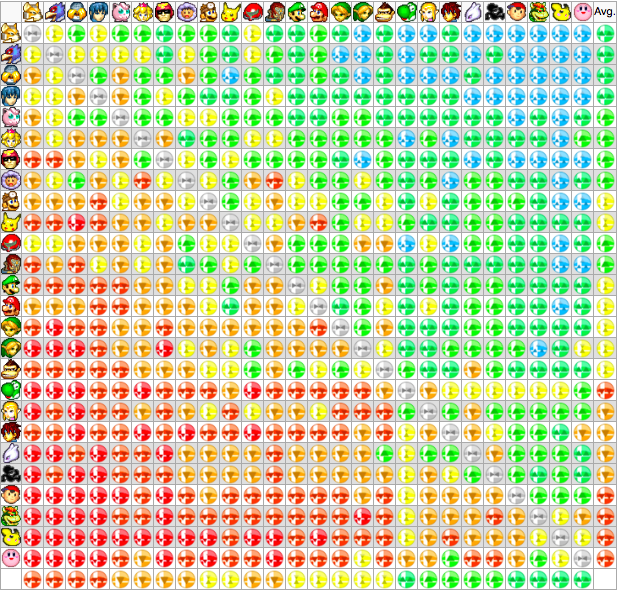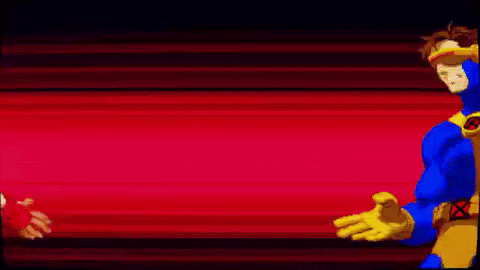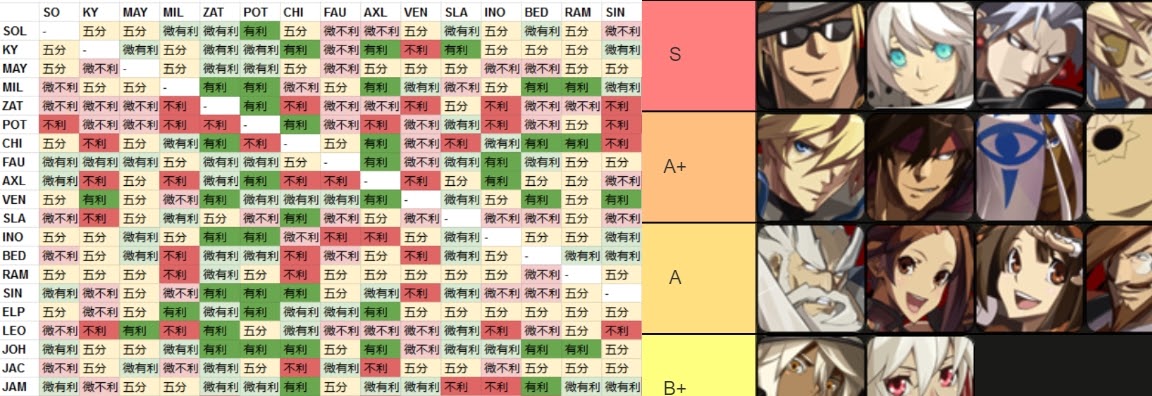No matter what the new fighting game is, there will always be one constant: The obsession with immediately finding character strengths and weaknesses. One of the first questions that arise from players both new and old is usually, “What does the tier list look like?” In fact, many study tiers before even looking toward specific characters’ playstyles when jumping into new games.
What is a tier list?
A tier list is a chart that categorizes fighting game characters based on how strong they are compared to the rest of the cast. Factors include tools, matchups, results, and personal opinions. While some tier lists are more detailed than others, they all can cast a bad light, leading many players to blindly believe them thanks to easily understandable designs. However, there is one charting tool that some find much more effective than standard tier lists.
What is a matchup chart?
That tool is the matchup chart, a spreadsheet that shows every fighter’s advantage or disadvantage against specific characters. For example, a matchup in Mortal Kombat 11 might be 60-40 in favor of your main character because of characteristics like frame data, zoning tools, and options that counter the other fighter’s strengths. That means when played optimally you should win six out of ten times. These charts break down every one versus one matchup with rows featuring either numbers, colors, or icons indicating difficulty.
Which is the better character guide: tier lists or matchup charts? While matchup charts have a slight edge, their flaws are just as prevalent as their counterpart.
The pros and cons of tier lists
Tier lists are the charting system of choice for the fighting game community for a couple of reasons. Not only are they easier to create thanks to simple drag and drop creation tools, but they also require less critical thinking. Instead of listing all of the character matchups of the game, you’re only considering general character strength and tournament stability.

Take Jibrill’s amazing Ultimate Marvel vs Capcom 3 tier list, for instance. It shows off not only accurate tiers in the game, but each order from top to bottom also speaks to each character’s degeneracy (A single one-dimensional strategy a character has that actually works in high-level tournament play) and tournament viability. While any character can do well through some crazy options, the accuracy of this list is proven by the fact that Zero and Morrigan down to Nova in the A+ tier, more consistently dominate others with less effort. They are also the characters you’ll usually find on high-placing tournament teams, save for a few exceptions.
However, for every good tier list, which takes years of matchup knowledge, tournament results, and strategies to create, there are 200 bad ones. Tier list culture has been blowing up for years, with social media and sites like Twitter and Tierlistmaker making them more accessible. Super-early tier lists, plain-bad tier lists, and too much reliance on inaccurate word of mouth have really plagued the age-old tool and made them truly controversial in the fighting game community.
Another issue associated with tier lists is that lower-level players often use them as substitutes for hard-earned fighting game experience. Rather than train with a fighter they love, they will simply pick a high-tiered fighter and expect to win based on the character's rankings. Lower-level players may also fall into the trap of reading tier lists without understanding how they were made and simply take them as law. It’s not all bad though, as tier lists do have high points to offset the bad, which we’ll get to after going into matchup charts.
What makes matchup charts better than tier lists?
Matchup charts are something you don’t see as much anymore—and for good reason. They take tons of group discussion and years of meta development (finding the optimal winning strategy) to create. While it’s easy for one person to make a matchup chart for their own main, it’s very difficult to compile data for an entire roster. The effort put into these charts make them inherently much more detailed than tier lists.

The forever-developing meta of a game like Super Smash Brothers Melee is one of the best examples of a matchup chart. It’s no exaggeration that decades of matchup experience, tournament results, and tech were put into this matchup chart. However, this doesn’t mean that it has no more faults than tier lists.
This chart doesn’t truly reflect something like tournament viability or placements. Fox, Falco, Marth, and Jigglypuff are, of course, near the top due to their strengths. However, their tournament stability, or ability to guarantee running their game plan to win, isn’t really described in much detail here. Not to mention, in games like this, there are ever-changing meta and characters that constantly move up and down in tournament results. This is most noticeable with characters like Pikachu, Dr. Mario, Yoshi, Luigi, Captain Falcon, Ice Climbers, and Peach.
Like other matchup charts, this one doesn’t explain why or how characters like Fox, Falco, or even Jigglypuff are some of the best, as each takes different skills to become proficient in every matchup.
A tale of two tier charts
The biggest downfall of both of these types of character charts goes back to what was discussed with tier lists. Each still comes from players that may see things differently. Just as character strengths are always debatable in the case of tier lists, matchup chart numbers are also disputable. The values of these lists will never be 100% agreed on, but this leads to the biggest positive.

Tier lists and matchup charts bring out some of the best discussions when it comes to the competitive future of characters and meta evolution. They won’t go anywhere anytime soon. Our advice is to try your best to ignore clickbait lists and never take any recommendation as an irrefutable fact. You’ll find them more useful as guides to find more ways to get better at your favorite game.
